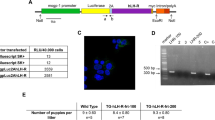Abstract
An experimental nude mouse system where human endometrial carcinomas of different histologic grade and steroid receptor characteristics can be grown and maintained under defined hormonal milieu by serial transplantation has been developed. Biologically and clinically important information on the role of steroid receptors in eliciting hormonal responses in these tumors has been obtained using this model. These results form the basis for designing and testing various treatment strategies for endometrial carcinomas of different histologic grade and receptor content.
Similar content being viewed by others
References
Silverberg E: Cancer Statistics. CA 32: 18, 1982
Kelley RM, Baker WH: Progestational agents in the treatment of carcinoma of the endometrium. N Engl J Med 264: 216–222, 1960
McGuire WL, Carbone PO, Vollmer EP: ‘Estrogen Receptors in Human Breast Cancer’. Raven Press, New York, 1975
Allegra JC, Lippman ME, Thompson EB, Simon R, Bartok A, Green L, Hupp KK, Do HMI, Aitken SC, Warren R: Relationship between the progesterone, androgen and glucocorticoid receptor and response rate to endocrine therapy in metastatic breast cancer. Cancer Treat Rep 62: 1281–1286, 1978
McGuire WL: ‘Hormones, Receptors and Breast Cancer’. Raven Press, New York, 1978
Mortel R, Zaino RJ, Satyaswaroop PG: Sex steroid receptors and hormonal treatment of endometrial cancer. In: Deppe G (ed) Chemotherapy of Gynecologic Cancer. Alan R Liss, Inc., N. Y., 1984, pp 125–138
Martin PM, Rolland PH, Gammere M, Serment H, Toga M: Estradiol and progesterone receptors in normal and neoplastic endometriums: Correlations between receptors, histopathological examinations and clinical responses under progestin therapy. Int J Cancer 24: 324–329, 1979
Benraad TJ, Friberg LG, Koenders AJM, Kullander S: Do estrogen and progesterone receptors in metastasizing endometrial cancers predict the response to gestagen therapy? Acta Obstet Gynecol Scand 59: 155–159, 1980
Creasman WT, McCartySr KS, Barton TK, McCartySr KS: Clinical correlates of estrogen and progesterone binding proteins in human endometrial adenocarcinoma. Obstet Gynecol 55: 363–370, 1980
Satyaswaroop PG, Mortel R: Failure of progestins to induce estradiol dehydrogenase activity in endometrial carcinoma. Cancer Res 42: 1322–1325, 1982
Mortel R, Zaino RJ, Satyaswaroop PG: Heterogeneity and progesterone receptor distribution in endometrial adenocarcinoma. Cancer 53: 113–116, 1984
Satyaswaroop PG, Zaino R, Mortel R: Human endometrial adenocarcinoma transplanted into nude mice: Growth regulation by estradiol. Science 219: 58–60, 1983
Shafie DM: Estrogen and the growth of breast cancer: New evidence suggests indirect action. Science 209: 701–702, 1980
Sirbasku DA, Benson RH: Estrogen-inducible growth factors that may act as mediators (estromedins) of estrogen-promoted tumor cell growth. In: Sato GH, Ross R (eds) Cold Spring Harbor Conference on Cell Proliferation. Cold Spring Harbor, N. Y., 1979, Vol 6, pp 477–497
Sirbasku DA: Estrogen-induction of growth factors specific for hormone-responsive mannary, pituitary, and kidney tumor cells. Proc Natl Acad Sci USA 75: 3786–3790, 1978
Satyaswaroop PG, Mortel R: Endometrial carcinoma: An aberration of endometrial cell differentiation. Am J Obstet Gynecol 140: 620–623, 1981
Tseng L, Gurpide E: Induction of human endometrial estradiol dehydrogenase by progestins. Endocrinology 92: 825–828, 1975
Satyaswaroop PG, Zaino RJ, Mortel R: Estrogen-like effect of tamoxifen on human endometrial carcinoma transplanted into nude mice. Cancer Res 44: 4006–4010, 1984
Swenerton KD, Shaw D, White GW, et al.. Treatment of advanced endometrial carcinoma with tamoxifen, N Engl J Med 301: 105, 1979
Swenerton KD: Treatment of advanced endometrial adenocarcinoma with tamoxifen. Cancer Treat Rep 64: 805–811, 1980
Bonte J, Ide P, Billiet G, et al.: Tamoxifen as a possible chemotherapeutic agent in endometrial adenocarcinoma. Gynecol Oncol 11: 140–161, 1981
Edmonson JH, Krook JE, Hilton JF, Long HJ, Cullinan SA, Everson LK, Malkasian GD: Ineffectiveness of Tamoxifen in Advanced Endometrial Carcinoma After Failure of Progestin Treatment. Cancer Treat Rep 70: 1019–1020, 1986
Bichon M, Bayard F: Dissociated effects of tamoxifen and oestradiol 17 on uterus and liver. J Steroid Biochem 10: 105–107, 1979
Fex G, Adielsson G, Mattson W: Oestrogen-like effects of tamoxifen on the concentration of proteins in plasma. Acta Endocrinol 97: 109–113, 1981
Gallez G, Henson JC, Waelbroek C: Growth-stimulating effect of nafoxidine on rat mannary tumor after ovariectomy. Eur J Cancer 9: 699–700, 1973
Helgason S, Wilking N, Carlstrom K, Damber MG, Schoultz BV: A comparative study of the estrogenic effects of tamoxifen and 17 estradiol in postmenopausal women. J Clin Endocrinol Metab 54: 404–408, 1982
Horwitz KB, Koseki Y, McGuire WL: Estrogen control of progesterone receptor in human breast cancer: role of estradiol and antiestrogen. Endocrinology 103: 1742–1751, 1978
Leavitt WW, Chen TJ, Allen TC: Regulation of progesterone receptor formation by estrogen action. Ann NY Acad Sci 286: 210–225, 1975
Legault-Poisson S, Jolivet J, Poisson R, Beretta-Piccoli M, Ban PR: Tamoxifen-induced tumor stimulation and with-drawal response. Cancer Treat Rep 63: 1839–1941, 1979
Martin L, Middleton E: Prolonged oestrogenic and mitrogenic activity of tamoxifen in the ovariectomized mouse. J Endocrinol 78: 125–129, 1978
Mortel R, Levy C, Wolff J-P, Nicholas J-C, Robel P, Baulieu E-E: Female sex steroid receptors in postmenopausal endometrial carcinoma and biochemical response to anticstrogen. Cancer Res 41: 1140–1147, 1981
Tsai LS, Katzenellenbogen BS: Antagonism of development and growth of 7, 12-dimethylbenz(a)anthracene-induced rat mammary tumors by the antiestrogen U23. 469 and effects on estrogen and progesterone receptors. Cancer Res 37: 1537–1543, 1977
Martin PM: Medroxyprogesterone acetate. In: Cavilli F, McGuire WL, Pannuti F, Pellegrini A, Cun GR (eds) Excerpta Medica, Switzerland, 1982, p 360
Killackey MA, Hakes TB, Pierce VK: Endometrial adenocarcinoma in breast cancer patients receiving anti-estrogens. Cancer Treat Rep 69: 237–239, 1985
Zaino RJ, Satyaswaroop PG, Mortel R: Morphology of human uterine carrier in nude mice. Arch Pathol Lab Med 108: 571–578, 1984
Zaino RJ, Satyaswaroop PG, Mortel R: Hormonal therapy of human endometrial carcinoma in a nude mouse model. Cancer Res 45: 539–541, 1985
Fluhmann CF: Squamous metaplasia in the rat uterus. Arch Pathol 59: 238–264, 1955
Author information
Authors and Affiliations
Rights and permissions
About this article
Cite this article
Satyaswaroop, P.G., Zaino, R.J. & Mortel, R. Steroid receptors and human endometrial carcinoma: studies in a nude mouse model. Cancer Metast Rev 6, 223–241 (1987). https://doi.org/10.1007/BF00144265
Issue Date:
DOI: https://doi.org/10.1007/BF00144265




